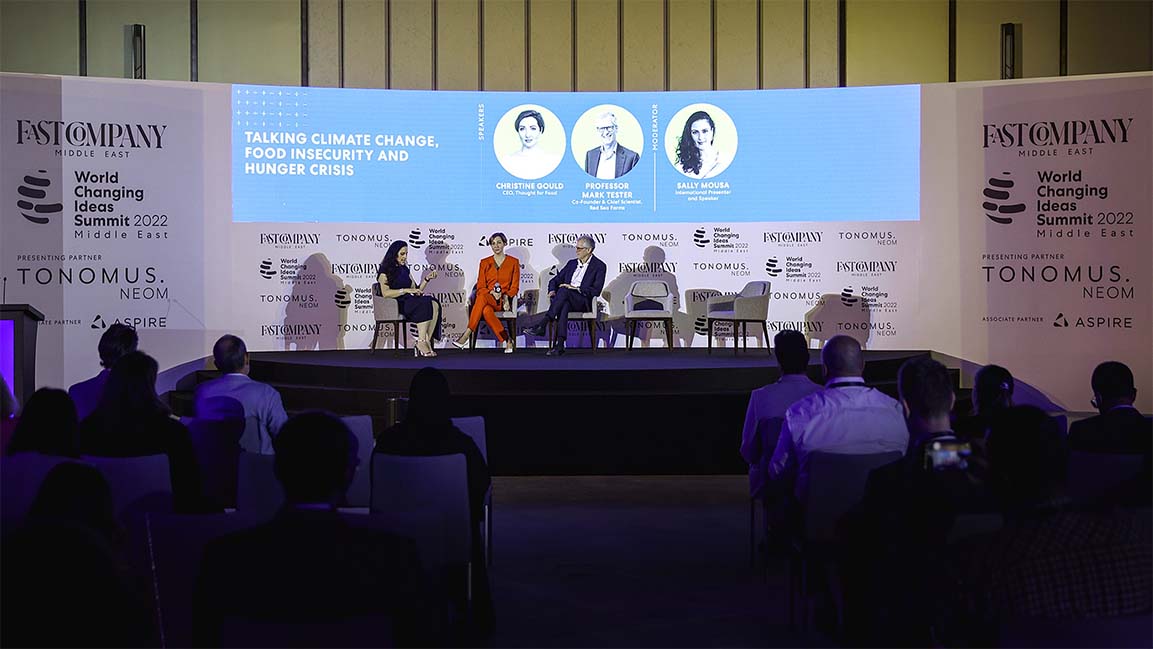- | 9:00 am
The world can feed 10 billion people sustainably by 2050. Here’s how
At the World Changing Ideas Summit, experts discussed how we can be ready to tackle food insecurity and hunger crises caused by climate change

Acute food insecurity is affecting millions due to the rising cost of food, fuel, and fertilizer, and the ripple effect of the pandemic and the war in Ukraine have contributed to the crises.
But bigger problems are coming. The global population is predicted to reach 10 billion by 2050. Will we produce enough food to feed them all?
According to the Food and Agriculture Organization, climate variability is responsible for 80% of the reasons for unpredictable harvests. And countries face the challenge of increasing food production without exacerbating environmental degradation and the climate crisis.
So, have we discovered long-term solutions to guarantee that enough food is produced globally to fulfill demand while ensuring everyone has access to it?
At the World Changing Ideas Summit in November, futurists and industry experts discussed how food production is a significant factor in the climate crisis.
“The uncertainties in the estimates are huge, and the planet has many challenges. Arguably, the food system is the most environmentally impactful of all human activities, more impactful than even energy,” says Professor Mark Tester, co-founder and chief scientist of Red Sea Farms.
The food sector, which uses half of the habitable land and 3/4th of the consumable water, is one of the biggest emitters of greenhouse gases. The food system impacts the environment, and then the environment further affects the food system.
“We’re doing terrible things like growing strawberries in California and then flying them to the Middle East so we can adorn our cakes and ice creams with them. The carbon footprint resulting from this is enormous,” Tester points out, adding that we have to change these things now.
CHANGING OLD WAYS
Despite what has been achieved over the past few decades in the form of the green revolution, which brought productive enhancements, the stunted growth in human development globally is an issue that remains to be addressed.
What is a possible solution? “What we can do is look at these challenges as opportunities to innovate new ways to work together and collaborate so that we can unlock the potential in our food system,” says Christine Gould, CEO of Thought for Food.
Dismissing popular beliefs that the food system is broken, Gould states that our food system works very well in the way it was designed, focusing on efficiency and optimization, and calories. “We can design a new system with the help of the largest youth population alive in history, which brings to the table a unique set of attributes, making them perfect agents for change around these global systemic challenges,” adds Gould.
Youngsters are often discouraged from taking up farming as a vocation due to the lack of growth in the sector, thereby affecting the industry’s ability to generate revenue.
Adding to the woes, the food sector is also known to be the least digitized industry, with the average age of the world’s farmers being over 65 years old. The need to bring creative ideas to this sector has become crucial.
“Through innovation, creativity, and collaboration, our world’s innovators need to be stepping up to solve the roadblocks the sector faces,” Gould adds.
INNOVATION IS THE WAY FORWARD
With biotechnology and nanotechnology available for deployment, there is a real potential for addressing the food sector’s current crises.
“We’ve got amazingly powerful weather predictions today, increasing farmers’ ability to manage growing and harvesting crops. With these weather predictions being almost accurate, they now know what to plant because they know they’re going to get it off before the weather conditions worsen,” says Tester.
Additionally, with plenty of research into growing different types of foods in brackish or salt water, the use of freshwater resources, which are depleting rapidly, can be minimized.
The need for deploying technologies has become the need of the hour, offering plenty of opportunities for innovators and entrepreneurs to roll out, with an ability to scale them for use.
“Technology is becoming faster and easier to use, offering more accessibility and affordability. That said, it’s not just about technology. It’s also about making these technologies and solutions more accessible and right-sized to the people who need to use them,” says Gould, stating how during COVID-19 when gallons of milk were dumped into waterways and eggs were thrown out. Food for Thought worked with Colombian farmers who could not get their produce to the market.
“We must actively explore new types of creative investment vehicles that fit the climate challenge to get solutions out there faster. We don’t have 20-year time horizons for these technologies to prove themselves. We have to link the on-the-ground solutions to places where they can get that incubation and support needed to gain access to capital,” adds Gould.
REGENERATIVE AGRICULTURE
Climate-smart and regenerative agriculture policies centered on farmers may boost crop yields and convert farms and pastures into carbon sinks, reverse forest loss, optimize nitrogen-based fertilizer use, and rethink global and local supply networks to be more sustainable and waste-free.
This systematic approach is critical for adopting the best sustainable practices that benefit the environment and climate. The future food system’s development can only work through collaborations, with science-based aims and actions that can scale up regenerative farming to restore ecosystems and reverse climate change.
“Regenerative agriculture is an exciting frontier for climate and can offer new economic opportunities for farmers,” says Gould, emphasizing how investments to help farmers transition to using sustainable products for their production is vital.








































